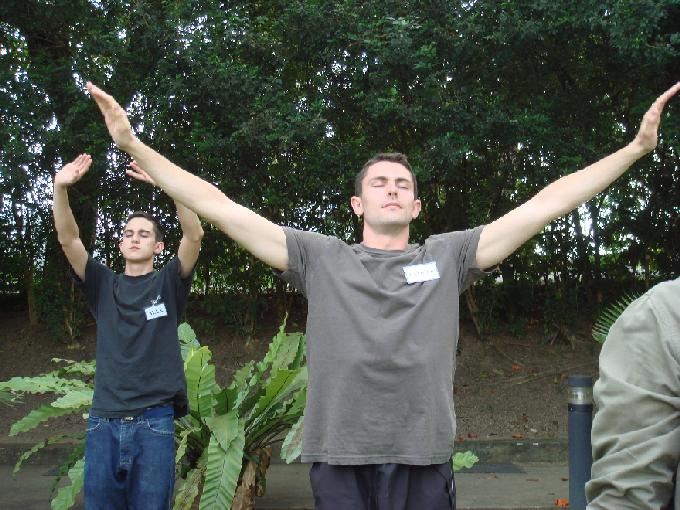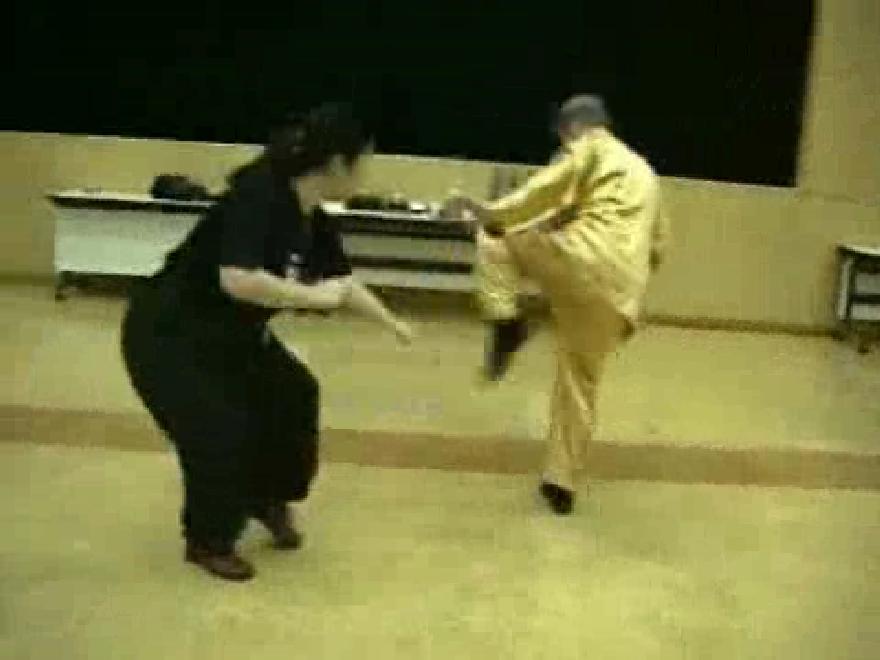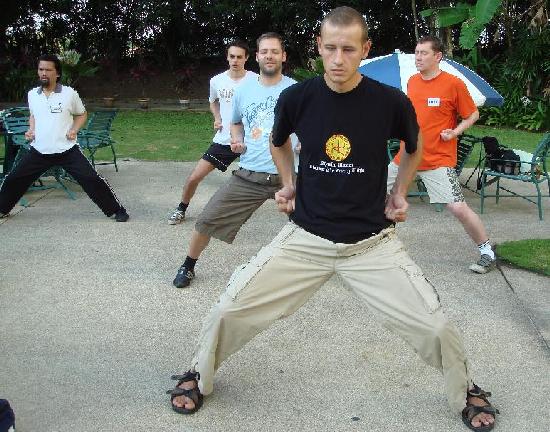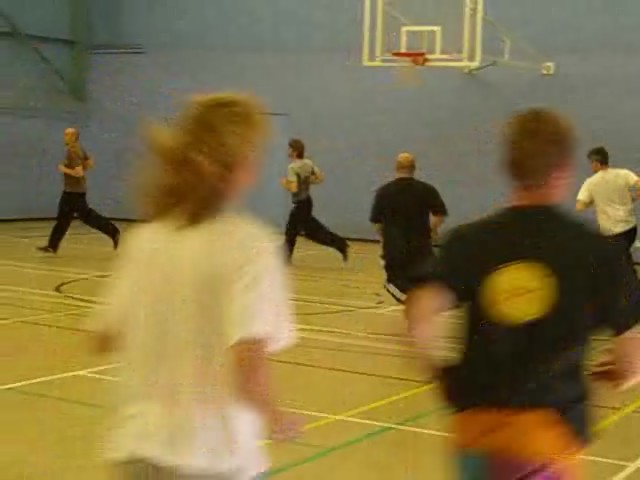February 2009 (Part 3)
SELECTION OF QUESTIONS AND ANSWERS

“Lifting the Sky” is one of the best exercises in all chi kung
Question 1
I have been practicing regularly the combination of Lifting The Sky, Chi Flow, and Standing Meditation. I am also practicing an exercise that makes me feel the best, which is the Horse-Riding Stance. Having practiced regularly the Horse-Riding Stance for several months, I am amazed that I could hold it easily for 5 minutes, something which I couldn't believe in the past, yet, paradoxically hoping being able to do it. Thanks to your instructions and useful tips as well as motivation to all your students on training.
— Jason, Malaysia
Answer
These are four of the best exercises in our school. Interestingly, while most people find the Horse-Riding Stance the most boring and difficult exercise to practice, many of our Shaolin Wahnam students find it a joy! Probably the most important reason is that our students know how to relax whereas most other people treat it as an endurance test, which is a big mistake.
Question 2
Whenever I walk, I feel that my steps are stable and light. I understand the key purpose for stance training is not for having powerful leg muscle, but I think it can help a little bit in other sports.
Answer
Your comment that your steps are “stable and light”, which of course is true, is most interesting. Many people may be honestly confused. Due to their dualistic thinking, they believe, erraneously, that if one is stable he would not be light, and vice versa, which is what they experience in daily life.
Then, how is it possible that we can be both “stable and light”, which is a manifestation of yin-yang harmony? Please note that we are stable and light at the same time, not that we can be stable at one time and light at another. The answer is chi. Similarly, in combat we can be powerful and fast at the same time. Most martial artists who use muscular strength will find that if they are fast they lack power, and if they are powerful they lack speed.
You are right to say that a key purpose of stance training is not for developing big leg muscles. But our leg muscles, despite not being big, can be very powerful. They are powerful not because of the flesh in the muscles but because of the chi in the muscles.
This reminds me of an interesting joke. According to science, butterflies are not supposed to fly because their wings are too flinsy to support their body weight. Yet butterflies can fly. Why? Because butterflies do not know science.
Similarly, according to science, we are not supposed to stand on our feet because our feet are too small to support our body weight. But, of course, we can stand on our feet. Why? Science does not have the answer. Scientists cannot give the same answers as for butterflies because we do know science, though not as much as the scientists.
Do you know why? The answer is chi. It is chi in our body that supports us, not our bones and muscles, just as it is the water in a hydrolic pump that supports a heavy truck, not the pieces of iron that makes up the pump.

Being stable and light at the same time is a hallmark of good kungfu, as demonstrated by Grandmaster Wong and Sifu Emiko above
Question 3
It was Beijing Olympics that brought sports fantasy in mid-August. One day, when I was feeling energetic after a stance training session, I went for a running, which I had not done for the past 5 years.
I ran with speed a little faster than jogging for 700 meters, but I was disappointed that my lower leg muscles sored halfway, and I was out of breath halfway too. I expected to run at least 3 kilometers. After this “incidence”, I had 5 days of muscular soreness. I found that the soreness was at my lower leg muscle, ankle joint, and a small area of muscles near the knee on my thigh. I guess these are the areas not trained in stance training.
Answer
It was not so. The reason why your leg muscles became sore and you became breathless was not due to the muscles not being trained in your stance training, but due to your not knowing how to use your muscles and your breathing correctly in your running.
Your main mistake was using your muscles and your breathing in the same way as people not trained in internal force use them, i.e. tensing your muscles and forcing your breathing.
The correct way of using your muscles and breathing in this case is not to use them consciously! Instead, you use your chi. In other words, it is your chi that does the running. As you do not use your muscles or your breathing, your muscles being sored and your breathing being short and fast, become irrelevant.
Many people may not understand what I have explained, but this is the basic philosophy behind why you were tired and breathless, whereas other Shaolin Wahnam students who have been properly trained, are not tired or panting even when they run for a greater distance or spar for a few hours.
But knowing the philosophy, while useful by itself, is insufficient to enable you to put it effectively into practice. You need the necessary skills. This is where learning personally from a competent teacher is important.
In some of my courses nowadays, I asked course participants to run round the training hall a few times. Of course I prepared them beforehand, and reminded them not to use their muscles and not to worry about their breathing. Some of the course participants were elderly, and many had not run for some time. Yet none of them were tired or panting after the run.
Question 4
However, there was no knee pain, pelvis pain and thigh muscle ache. I guess these areas benefited from stance training.
Answer
The reason was not what you thought, but was the same as why your leg muscles were tired and you were panting. In your running, you stressed your leg muscles and breathing, but not your knees and thighs.
Question 5
So I am trying to make some “layman” assumptions as follows, and would like to get your opinions:-
The ability of running long and fast will depend on the muscular strength of legs and feet, apart from having the ability of regulating breath.
Compared to stance training, running is exhausting, making people tired, but stance training is replenishing, making people feeling good.
The ability to sit long on proper Horse-Riding Stance does not make someone being able to run long or run fast.
Someone proficient in chi kung and has abundance of chi will still have difficulty in running long and fast without panting, if the person does not run regularly.
Even though one can regulate breathing very well as in the Art of Thousand Steps described in your book, his leg muscle strength is also crucial at sustaining a long-distance running.
Answer
You made a very common mistake many people make, i.e. you derive your answers from intellectualization and not from experience. This does not mean that intellectualization is not useful, but in cases involving internal force and other disciplines not normally understood by most people, the answers derived from intellectualization are often incorrect.
It is actually not difficult to intellectualize why this is so, and in this case it is confirmed by experience. People base their intellectualization on a common paradigm. When they intellectualize on uncommon topics, like internal force and chi kung healing, they forget that their common paradigm does not apply. So they still use their common paradigm, which in the case of uncommon topics, is a wrong paradigm. Conclusions based on a wrong paradigm are unlikely to be correct.
This actually happens very often in daily life, and even very intelligent people make this mistake. For example when a person suffers from diabetes or cancer, according to the common paradigm he has too much sugar or a tumour in his system. If he sees a chi kung healer who does not even talk about his sugar or tunour, it is easy for many people to accuse the chi kung healer as a charlatan.
They may even think their accusation reasonable, reasoning how could any healer who does not know about sugar and tumour cure a patient suffering from excessive sugar or a tumour. Even when the patient is actually cured, these people still cannot accept that it is chi kung healing that is responsible for the recovery. In fact they are unreasonable. They impose a paradigm that is not relevant.
They do not realize that a paradigm is not a set of truths, but just a particular way of viewing things. For example, classifying food as proteins, carbohydrates, fats, etc. is a paradigm, a particular way of vewing things, not a set of truth. People who do not classify food in this way, like many traditional Chinese and Indians who classify food as cold, hot, dry and damp, still have their food digested even when Western educated people classify the very same food as proteins, carbohydrates, fats, etc.
Similarly, regarding a patient as suffering from excessive sugar or a tumour is a paradigm, a particular way of viewing illness. Traditional chi kung healers use a different paradigm; they regard the same patient as suffering from some energy blockage. Now let us compare the common paradigm with the chi kung paradigm in viewing the events below.

It may be a surprise to the uninitiated that one of the best methods to be stable and light at the same time is the Horse-Riding Stance as shown above by participants of the Special Shaolin Kungfu Course of April 2007
Question 6
The ability of running long and fast will depend on the muscular strength of legs and feet, apart from having the ability of regulating breath.
Answer
This is the common paradigm. The chi kung paradigm is different. The said ability does not depend on muscular strength, but on an effective use of energy flow. The better his energy flow, the more able the person is in running long and fast.
Regarding the second part of the statement, regulating breath is an immediate cause for running long and fast, the root cause is energy flow. In other words, if he regulates his breath so that his energy flow is smooth, he can run long and fast. But if his breath regulation is forced or mechanical, which hinders smooth energy flow, it would hinder rather than contribute to running long and fast.
It is important to note that when we use the chi kung paradigm, we do not necessarily mean that the common paradigm is not useful. In everyday circumstances, a person with stronger muscular legs and feet would run longer and faster than another with weaker ones. But with the exception of top-class runners who actually use the chi kung paradigm without their conscious knowing, people with stronger leg and feet muscles may not run as fast or as long as chi kung practitioners.
Question 7
Compared to stance training, running is exhausting, making people tired, but stance training is replenishing, making people feeling good.
Answer
This is not true in both the common paradigm and the chi kung paradigm. In the common paradigm, people who can run for 5 minutes usually cannot remain at the Horse-Riding Stance for the same length of time. They will also find themselves more exhausted and tired performing stance training than running.
Even marathon runners who can run for miles and hours may not remain at the Horse-Riding Stance for 5 minutes without feeling exhausted. But this is not a fair comparision because different skills are involved. In other words, they have the energy and skills to run for miles and hours. The same energy is more than sufficient to last 5 minutes in a Horse-Riding Stance, but they do not have the skills to do so without feeling exhausted.
In the chi kung paradigm, both stance training and running are exhausting if performed wrongly, and both are replenishing when performed correctly. In my Intensive Shaolin Kungfu Course and Intensive Taijiquan Course, for example, course participants have more energy after sparring for a few hours than before, and for ordinary persons, sparring is more exhausting than running.
Question 8
The ability to sit long on proper Horse-Riding Stance does not make someone being able to run long or run fast.
Answer
This is incorrect in both the common paradigm and the chi kung paradigm.
In the common paradigm, proper Horse-Riding Stance training strengthens leg muscles as well as improves physical endurance, resulting in better ability in running long and fast.
In the chi kung paradigm, proper Horse-Riding Stance training enhances energy flow and mental clarity, which also result in the practitioner being able to perform better no matter what he does, including running long and fast.
In your case, as you had not run for 5 years, running for 700 metres and having sored legs and panting halfway was not bad. Most people today may not run for 100 metres without becoming exhausted. If you had not practiced Horse-Riding Stance, you might not have done better.

Participants of a chi kung course at the UK Summer Camp could run many times round the training hall without being tired or panting for breath
Question 9
Someone proficient in chi kung and has abundance of chi will still have difficulty in running long and fast without panting, if the person does not run regularly.
Answer
You came to this wrong conclusion because you used the common paradigm. In the chi kung paradigm, a proficient chi kung practitioner could still run long and fast without having run regularly if he could use chi to do his running. Of course he would perform much better if he runs regularly, in which case he would have develop the Art of Lightness.
In the example I gave earlier, most of the course participants did not run regularly, yet they could run round the hall a few times without feeling tired or panting. Some of them reported that it was the first time they had run for years.
I recall an illuminating incident many years ago. I was then teaching at the Shaolin Wahnam Association in Sungai Petani. It rained cats and dogs while we had our kungfu session. Although the rain had subsided into a drizzle when our kungfu session was over, many roads were flooded and we could not drive home.
It was evident that the flood water would not subside for an hour or two. A student, who was a regular marathon runner, asked me whether I would be interested to run home with him. I said it would be more fun running in the drizzle than waiting for the flood water to subside.
My student was considerate. Knowing that I had not run for a long time, he kept asking me while we were running whether I wanted to stop, and I kept telling him I was fine. Our houses, which were near to each other, were about 6 kilometres from the Association. We reached home safely, without feeling tired or panting.
Question 10
Even though one can regulate breathing very well as in the Art of Thousand Steps described in your book, his leg muscle strength is also crucial at sustaining a long-distance running.
Answer
It may sound crazy to many people used to the common paradigm, but if a student practices the Art of Thousand Steps correctly as chi kung, his leg muscle strength is not a crucial factor at all even at the beginning stage of his training. Of course he must have sufficient strength to stand and run, otherwise he should not attempt this Art of Thousand Steps in the first place.
As he continues his training, he will strengthen his legs and overall physical body, without substantially increasing the size of his muscles, as well as his emotional, mental and spiritual well-being.
In principle, it is similar to some of our Shaolin Wahnam practitioners with gentle hands being able to break bricks, or small-sized female students handling hefty men in sparring.
Question 11
And finally, you have mentioned that running or jogging is actually detrimental to health in your book, yet the Art of Thousand Steps is one of the arts in Shaolin Wahnam. If appropriate, I'd like to ask for your advice as how chi kung can help negate the detrimental effect of regular running, especially on knee and feet.
Answer
Humans are built for walking, not running or jogging. We may run for special reasons, but using running or jogging as a means to promote health and fitness is confusing cause and effect. The ability to run or jog well is the result, not the cause, of good health.
Running or jogging is detrimental to health because it forces the runner's internal organs to overwork, often excessively. For example, his heart is built to beat between 60 to 80 times a minute, but when he runs he forces his heart to over-work at more than 150 beats a minute.
When he is young, his over-worked organs may stand the punishment, though the harm is done. But by the time he reaches middle-age, the harmful effects of over-working his organs may surface.
The Art of Thousand Steps is different from running or jogging as practiced by most people. Running or jogging is a physical exercise, whereas the Art of Thousand Steps is chi kung. A crucial difference, amongst many, is that in physical exericse you use muscles, whereas in chi kung you use chi.
Hence, there is no need to use chi kung to negate the detrimental effect of running done in the Art of Thousand Steps, because the running done in the Art of Thousand Steps is chi kung itself. In the first place, there are no detrimental effects because this special way of chi kung running is different from physical running.
In physical running, more serious than sored muscles and injured knees is the insideous harm done to internal organs, especially the heart, lungs and kidneys. As runners and joggers need more energy than normal time, their breathing is more concerned with grasping for air than breathing out toxic waste, which is also produced in more amount than in normal time.
This results in toxic waste clogging their systems, which has long-reaching but insidious harmful effects. For example, when toxic waste clogs some nerves, it may result in mal-function of their related organs or glans. It is unlikely that the sufferers or their doctors could trace the cause to energy blockage due to clogging of toxic waste as a result of running or jogging.
Practicing chi kung, including the Art of Thousand Steps, generates energy flow that helps to clear such blockage. The energy flow also repairs damage done to internal organs and then nourishes them. Hence, physical running or jogging drains away energy and causes energy blockage, thus is detrimental to health, whereas the Art of Thousand Steps increases energy levels and enhances smooth energy flow, thus contributing to health, vitality and longevity.
LINKS
Selected Reading
- Yin-Yang, God and Health
- Flowery Language in Buddhist Writings
- Chi Kung - the Art of Developing Vital Energy
- How would a Shaolin exponent Counter against the following Karate Attacks
- Learning a Variety of Weapon Sets
